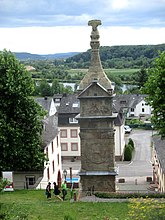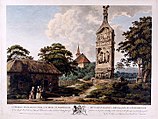Igeler pillar

The Igeler pillar in the village of Igel on the Moselle is, next to the Drususstein in Mainz, the only Roman tomb north of the Alps that has been preserved above ground at its original location since ancient times .
description
The pillar monument made of red sandstone is about 23 m high and richly decorated with reliefs. These show scenes from the everyday and professional life of the cloth merchants as well as from mythology and were originally colored, like most ancient sculptures. At the beginning of scientific research in the 19th century, only a few remains of the colorful painting were left. A colored reconstruction of the column is in the Rheinisches Landesmuseum in Trier.
The top of the pillar is decorated with a sculpture of an eagle with outspread wings. Today it is very badly weathered and hardly recognizable as an eagle.
Establishment
The Igel column was built in the 3rd century AD, although the exact date is disputed. While Hans Dragendorff and Emil Krüger placed the tomb in the second third of the century, some - but not all - of the younger researchers suggested an earlier chronological classification, around the first decades of the third century. In her historical comparison of the Roman grave monuments in the Trier region, Margot Baltzer counts the Igel column in what she calls the “Severan group”, which she dates to around 200–215.
As the inscription on it shows, the column was erected by the brothers Lucius Secundinius Aventinus and Lucius Secundinius Securus. According to the shape and the inscription, it is a grave monument, however, no burial in the immediate vicinity has been proven during excavations. It is therefore possible that it only served as a cenotaph ("sham grave"), while the graves of the builders and their deceased relatives were on their private property. In addition to the memory of the dead of the family, the memorial probably also had the purpose of advertising the cloth trade of the builder family.
Post-ancient history
The Igel Column escaped destruction after the fall of the Roman Empire due to the fact that in the Middle Ages the main picture on the south side was believed to be a representation of the marriage of Constantius Chlorus to St. Helena , mother of Constantine the Great . Nevertheless, from the Middle Ages on, some damage occurred, for example through attempts to tear the iron clips between the stones out of the monument due to their metal value. In the 16th century, the Spanish governor of Luxembourg, Peter Ernst I von Mansfeld , who was very interested in art and antiquity, is said to have planned to demolish the monument and rebuild it in the park of his castle in Clausen . It is unclear whether this is the case; severe damage in the lower area of the monument could in any case stem from a failed attempt at dismantling.
The place name Igel is traditionally derived from the Latin word for eagle , aquila (cf. the English word "eagle", which also comes from this). Eberhard Zahn, on the other hand, took the view that the name goes back to the medieval Latin name agulia , which was used to designate the ancient obelisks in Rome . In both cases, however, the name of the community is traced back to the distinctive grave monument of the Secundinier (see also the section "Name" in the article "Igel (Mosel)" ).
Reception and exploration
The Bolognese nobleman Fulvio Ruggieri accompanied the papal special nuncio Giovanni Francesco Commendone, Bishop of Zante , to Trier and visited the Igel column on January 14, 1562, which he describes briefly in his travel report. The first images of the monument, which served as illustrations for various historical or geographical treatises, also date from this period.
Johann Wolfgang von Goethe visited the Igel Column on August 26th and October 22nd or 23rd, 1792; afterwards he described and drawn them. Afterwards he often spoke about the ancient monument. Among other things, he wrote about it in the autobiographical campaign in France on August 23:
“On the way from Trier to Luxembourg, I soon enjoyed the monument near Igel. Since I knew how happily the ancients knew how to erect their buildings and monuments, I immediately threw away all the village huts in my mind, and now it was in the most worthy place. The Moselle flows directly past, with which a considerable water, the Saar, connects opposite; the curvature of the water, the ascent and descent of the earth, a lush vegetation give the place loveliness and dignity. "
And on October 22nd:
“Perhaps the power of antiquity was never felt more than in this contrast: a monument, even of warlike times, but nevertheless happy, victorious days and a lasting well-being of active people in this area. Although it was built at a later time under the Antonines, it still retains so many properties of excellent art that on the whole it speaks gracefully to us and from its parts, although very damaged, communicates the feeling of a happy and active existence. "
The Sayner Hütte near Bendorf am Rhein, which had specialized in replicating antique models using the art casting process, created a 19-inch replica of the Igel column in 1829 based on a design by the art form maker Heinrich Zumpft and based on drawings by Carl Osterwald. One of the first bronze casts went to Goethe in Weimar in May 1829.
Tourism and monument protection
Today the Igeler column is the main attraction of the place and is frequented by visitors. This fact was taken into account with the installation of various information boards and the creation of the so-called column garden on the slope opposite the cultural monument. Not far from the Igel Column in a vineyard slope is the Grutenhäuschen, a reconstructed Roman tomb. In 1906, a replica of the Igel column was built in the courtyard of the Rheinisches Landesmuseum Trier , on which the original color of the monument was reconstructed in 1993.
The Igler column is a protected cultural monument according to the Monument Protection Act (DSchG) and entered in the list of monuments of the state of Rhineland-Palatinate . It is on Trierer Strasse .
Since 1986 the Igeler pillar has been part of the UNESCO World Heritage Site Roman Monuments, Cathedral and Church of Our Lady in Trier . Furthermore, it is a protected cultural asset according to the Hague Convention and marked with the blue and white trademark.
literature
- Margot Baltzer: The everyday representations of the Treverian grave monuments. In: Trier magazine for the history and art of the Trier region and its neighboring areas. Year 46, 1983, pp. 7–151, here pp. 21 and 36.
- Heinz Cüppers : Working and observing the Igel column. In: Trier magazine for the history and art of the Trier country and its neighboring areas. Volume 31, 1968, pp. 222–226.
- Hans Dragendorff , Emil Krüger: The tomb of Igel . Lintz, Trier 1924.
- Friedrich Drexel : The pictures of the Igel column. In: Communications of the German Archaeological Institute, Roman Department . Volume 35, 1920, pp. 84-142.
- Jérôme France, Hans-Peter Kuhnen, François Richard (eds.): La colonne de Igel. Société et religion au III e siècle après J.-C. Actes des journées d'étude de Nancy et Trêves, 21–22 September 2000 (= Annales de l'Est. 2001, Volume 2). Presses universitaires de Nancy, Nancy 2001.
- Franz Kugler : The Roman monument to the hedgehog. Ms. Lintz, Trier 1846. (digitized version)
- Andreas Mehl : Economy, society, belief in the dead. The "Igeler Pillar" near Trier and its grave lords. In: Laverna. Volume 8, 1997, pp. 59-92.
- Jacques Mersch: La Colonne d'Igel. Essai historique et iconographique / The monument of the hedgehog. Historical-iconographic study (= Publications Mosellanes. Volume 24). Les Publications Mosellanes, Luxembourg 1985 (mainly on the reception and research history of the Igel column based on the illustrations it made).
- Eberhard Zahn: The new reconstruction drawing of the Igel column. In: Trier magazine for the history and art of the Trier country and its neighboring areas. Volume 31, 1968, pp. 227-234.
- Eberhard Zahn: The Igel column in Igel near Trier (= Rheinische Kunststätten. Issue 38). 5th edition. Neuss printing and publishing house, Neuss 1982, ISBN 3-88094-425-5 .
Web links
- Official website of the Igel Column
- Entry on the so -called Igel column (Igel municipality) in the database of cultural assets in the Trier region .
Individual evidence
- ↑ Hans Dragendorff, Emil Krüger: The tomb of Igel . Lintz, Trier 1924, p. 101 f.
- ↑ An overview of further dating suggestions is given by Andreas Mehl : Wirtschaft, Gesellschaft, Totenglauben. The "Igeler Pillar" near Trier and its grave lords. In: Laverna. Volume 8, 1997, pp. 59-92, here p. 60, note 3.
- ^ Margot Baltzer: The everyday representations of the Treverian grave monuments. In: Trier magazine for the history and art of the Trier region and its neighboring areas. Year 46, 1983, pp. 7–151, here p. 21.
- ↑ a b Eberhard Zahn: The Igel column in Igel near Trier. 5th edition. Neusser Druckerei und Verlag, Neuss 1982, ISBN 3-88094-425-5 , p. 35.
- ↑ Dragendorff / Krüger (see section Literature), pp. 13-14
- ^ Adam Wandruszka: Kurtrier four centuries ago. In: Kur-Trierisches Jahrbuch. 9th year, 1969, p. 129 ff.
- ↑ See the compilation and reproductions in Mersch, La Colonne d'Igel.
- ^ Goethe's drawing of the Igel column, original in the Kupferstichkabinett, Staatl. Museums Preuss. Cultural property.
- ^ Karl-Heinz Weichert: Goethe and the Igel column. In: Goethe in Trier and Luxemburg. 200 years of the campaign in France 1792. Catalog of the exhibition of the Trier City Library, the Luxembourg National Library and the Weimar Classic Foundation. 1992, ISBN 2-87980-005-6 , pp. 102-123.
- ^ Karl-Heinz Weichert: Goethe and the Igel column. In: Goethe in Trier and Luxemburg. 200 years of the campaign in France 1792. Catalog of the exhibition of the Trier City Library, the Luxembourg National Library and the Weimar Classic Foundation. 1992, ISBN 2-87980-005-6 , p. 108.
- ^ General Directorate for Cultural Heritage Rhineland-Palatinate (ed.): Informational directory of cultural monuments - District of Trier-Saarburg. Mainz 2020, p. 17 (PDF; 6.5 MB).
Coordinates: 49 ° 42 ′ 33 " N , 6 ° 32 ′ 58" E



